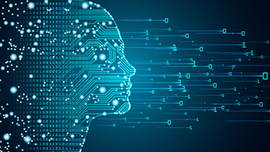Glossary
A B C D E F G H I J K L M N O P Q R S T U V W X Y Z
A
ALGORITHM
Finite suite of formal rules (logical operations, instructions) allowing to obtain a result from input elements. This suite can be the object of an automated execution process and rely on models designed through machine learning.
ARTIFICIAL INTELLIGENCE (AI)
A set of sciences, theories and techniques whose purpose is to reproduce by a machine the cognitive abilities of a human being. Current developments aim to be able to entrust a machine with complex tasks previously delegated to a human.
However, the term artificial intelligence is criticized by experts who distinguish between "strong" AI (who are able to contextualize very different specialized problems completely independently) and "weak" or "moderate" AI (who perform extremely well in their field of training). According to some experts, "strong" AI would require advances in basic research to be able to model the world as a whole and not just improvements in the performance of existing systems.
B
BIG DATA
The term "big data" refers to a large heterogeneous data set (open data, proprietary data, commercially purchased data).
C
CHATBOT (conversational agent)
Conversational agent that dialogues with its user (for example: empathic robots available to patients, or automated conversation services in customer relations).
D
DATABASE
A database is a "container" storing data such as numbers, dates or words, which can be reprocessed by computer means to produce information; for example, numbers and names assembled and sorted to form a directory.
DATAMINING (Data analysis and mining)
Datamining makes it possible to analyze a large volume of data and bring out models, correlations and trends.
DATA SCIENCE
A broad grouping of mathematics, statistics, probability, computing, data visualization to extract knowledge from a heterogeneous set of data (images, sound, text, genomic data, social network links, physical measurements, etc.).
The methods and tools derived from artificial intelligence are part of this family.
DEEP LEARNING
See Machine learning and Neural Network
M
MACHINE LEARNING
Machine learning makes it possible to construct a mathematical model from data, including a large number of variables that are not known in advance. The parameters are configured as you go through a learning phase, which uses training data sets to find links and classifies them. The different machine learning methods are chosen by the designers according to the nature of the tasks to be performed (grouping, decision tree). These methods are usually classified into 3 categories: human-supervised learning, unsupervised learning, and unsupervised learning by reinforcement. These 3 categories group together different methods including neural networks, deep learning etc.
Example of classification and applications
METADATA
Data used to define, contextualize or characterize other data.
N
NEURAL NETWORK (artificial) / FORMAL NEURON
Algorithmic system, whose design was originally schematically inspired by the functioning of biological neurons and which, subsequently, came close to statistical methods.
The so-called formal neuron is designed as an automaton with a transfer function that transforms its inputs into outputs according to precise logical, arithmetic and symbolic rules. Assembled in a network, these formal neurons are able to quickly operate classifications and gradually learn to improve them.
This type of learning has been tested by tests on games (Go, video games). It is used for robotics, automated translation, etc.
O
OPEN DATA
The term refers to the public availability, by download, of structured databases. These data may be re-used in a non-monetary way under the conditions of a specific licence, which may in particular specify or prohibit certain purposes of re-use.
Open data is not to be confused with unitary public information available on Internet sites, the entire database of which cannot be downloaded (for example case law databases). It does not replace the mandatory publication of certain administrative or judicial measures or decisions already enacted by certain laws or regulations.
Finally, confusion is sometimes created between the data (open data strictly speaking) and their means of processing (machine learning, data science) for different purposes (search engines, assistance in drafting acts, analysis of jurisprudential trends, anticipation of court decisions).
P
PERSONAL DATA
Information relating to an identified or identifiable natural person, directly or indirectly, by reference to one or more elements specific to that person.
Among these, sensitive data within the meaning of the General Data Protection Regulation concern personal data relating to racial or ethnic origin, political opinions, religious or philosophical beliefs, trade union membership, as well as genetic data, biometric data, data concerning health or concerning sex life or sexual orientation.
PERSONAL DATA PROCESSING
Any operation or set of operations performed or not using automated processes and applied to personal data or sets of data, such as collection, recording, organisation, structuring, storage, adaptation or modification, retrieval, consultation, use, communication by transmission, dissemination or any other form of making available, linking or interconnection, limitation, erasure or destruction.
PROFILING
According to Article 4(4) of the GDPR, personal data are processed for the purpose of evaluating certain aspects of a natural person's life (economic situation, health, personal preferences, etc.).
PSEUDONYMISATION
According to Article 4 of the GDPR, personal data may no longer be attributed to a specific data subject without recourse to additional information, provided that this additional information is kept separately and subject to technical and organisational measures to ensure that the personal data are not attributed to an identified or identifiable natural person.



